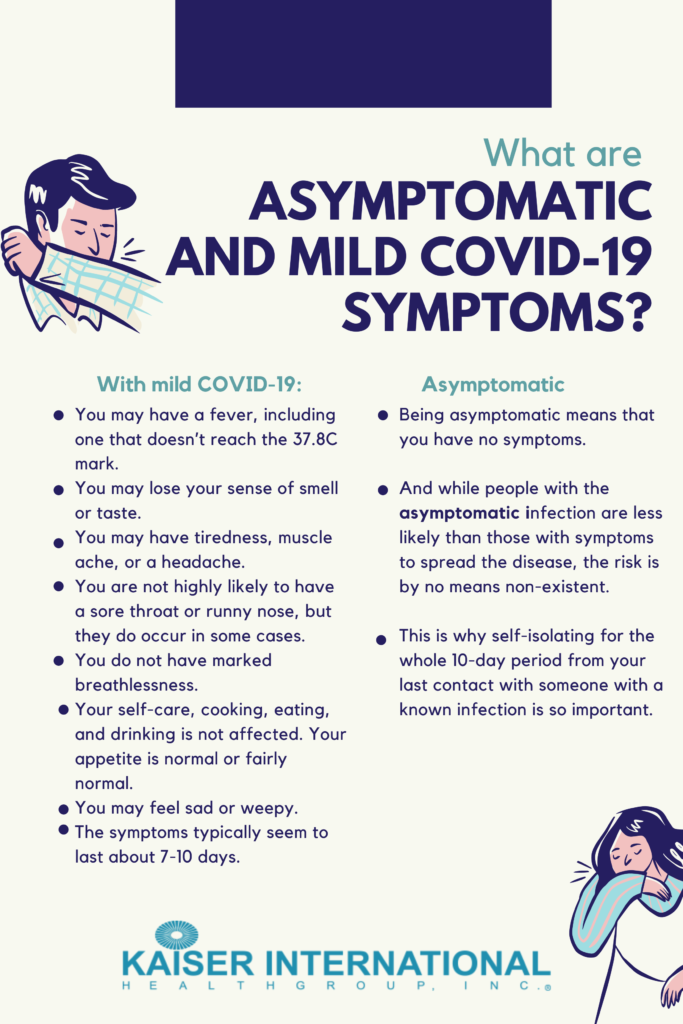WHAT ARE ASYMPTOMATIC AND MILD COVID-19 SYMPTOMS?
The virus affects mainly your upper respiratory tract, primarily the large airways. Key symptoms are temperature, a new continuous cough, and/or a loss of your sense of smell or taste.
Patients with the mild illness have flu-like symptoms. These may include a dry cough and mild fever, but the fever may not reach 37.8C, and there may sometimes be little or even no cough. Patients might notice a feeling of being a bit more breathless than normal on exercise, but they are not out of breath on normal household activity.
With mild COVID-19:
You may well not fit any classification exactly. You may be between two. You may move from mild to moderate symptoms, then back to mild. You may have symptoms from more than one group. Illness is like that.
When huge numbers of people are affected, they will not all fit perfectly into simple group classifications of mild, moderate, or severe. But if your symptoms are predominantly of mild disease with, say, one or two moderate features, you may be mild to moderate.
1. You may have a fever, including one that doesn’t reach the 37.8C mark.
2. You may lose your sense of smell or taste.
3. You may have tiredness, muscle ache, or a headache.
4. You are not highly likely to have a sore throat or runny nose, but they do occur in some cases.
5. You do not have marked breathlessness.
6. Your self-care, cooking, eating, and drinking is not affected. Your appetite is normal or fairly normal.
7. You may feel sad or weepy.
8. The symptoms typically seem to last about 7-10 days.
If your symptoms are predominantly moderate, but you are clearly getting worse and start to get symptoms that seem to fit ‘severe’, do not wait to seek urgent help until you have more of the severe symptoms.
In each category, most people will not progress to the next. You are more likely to progress if you are vulnerable, particularly if you are over 60. If you are in a very vulnerable group and you think you have even mild COVID-19, you should seek advice.
Asymptomatic COVID-19
The government guidelines suggest that 1 in 3 people who have COVID-19 have no symptoms. It seems that this occurs more often in the healthiest and the younger age groups, including most children.
Antibody testing helps us to understand how many people have had coronavirus unknowingly, with or without symptoms. At the moment, whether you can book antibody testing depends on your job and where you live. In most situations, it is not available on the NHS.
Being asymptomatic means that you have no symptoms. If you live in a house with people with a COVID-19 infection and you have no symptoms, you may be an asymptomatic case. However, recent research suggests that the proportion of people who remain completely asymptomatic is lower than first thought, at about 1 in 5 people.
And while people with the asymptomatic infection are less likely than those with symptoms to spread the disease, the risk is by no means non-existent. This is why self-isolating for the whole 10-day period from your last contact with someone with a known infection is so important.
If you have symptoms that are worsening, seek advice. This is particularly true if you have any of the severe features. People with COVID-19, particularly those in risk groups, can deteriorate from mild to severe. Likewise, if you are afraid please seek advice.
If you think that you have the following symptoms, then you should seek professional and medical help. It can really be beneficial and it can prevent your symptoms from worsening or developing.
Check out Kaiser International Health Group if you’re looking for a health care provider that can help maintain your physical, and mental health in peak condition. Get Kaiser Health Care now!
